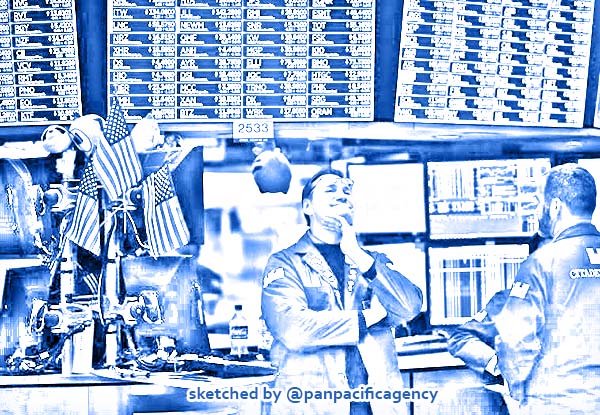[Analytics] A time for cautious buying of stocks

US stocks. Photo: AFP/Johannes Eisele. Sketched by the Pan Pacific Agency.
World stock markets regained some of the ground lost in yesterday’s record (in the MSCI World Index) crash, after Germany announced that it would spend whatever it needed to protect its economy and the Fed seemed poised to cut its overnight rate to zero. I have been flooded with questions about market timing: After a nearly 30% peak-to-trough decline in US equity prices, is it time to buy? David P. Goldman specially for the Asia Times.
That depends on what you’re buying. Many companies turned the sow’s ear of total earnings into the silk purse of earnings per share through equity buybacks, reducing the number of shares outstanding rather than increasing top-line earnings.
Top-line pre-tax profits have been declining since 2014, and sharply.
Late last year, Goldman Sachs analysts calculated that most purchases of shares came from corporations buying their own stock. If that sounds like a Ponzi scheme, it isn’t: There’s nothing in principle wrong with returning money to shareholders if you can’t make profitable new investments at the margin. The problem is: Where does corporate America get the money to buy back its own shares?
To buy back their shares, US corporations have borrowed at increasingly lower credit ratings (credit ratings deteriorate when you issue more debt and less equity). The chart below (from the Evergreen Gavekal blog shows the impressive increase in debt with the lowest investment grade, Baa/BBB.
There are a number of reasons why the credit market will be less enthusiastic about lending money to corporations that want to buy back their own shares.
First, the cost of corporate borrowing on average jumped during the past two weeks as equity markets crashed.
Treasury yields fell drastically, but corporate yields rose for Baa/BBB borrowers, the part of the market that has done most of the financing.
Not only have corporate spreads (the difference between corporate yields and Treasury yields) risen, but the spreads of ultra-safe assets like mortgage-backed securities issue by the Federal National Mortgage Association have risen as well.
As I reported yesterday in Asia Times, the collapse of European bank equity prices by roughly half during the past three weeks set a vicious cycle into motion. The credit quality of overseas banks deteriorated sharply, and American banks rationed interbank loans to their European and Japanese counterparts. This forced the banks to sell assets, and also forced them to stop providing hedges to institutional investors for the foreign exchange risk of owning dollar-denominated bonds. The institutional investors in turn sold into a declining market. That is why the Federal Reserve stepped in with $1 trillion worth of securities purchases. That took the immediate pressure off the jugular for foreign banks, but it hasn’t produced much of a rally in corporate or mortgage-backed bonds today.
Demand for US corporate debt is likely to be more restrained, the cost of debt is likely to be higher, and the ability of corporations to borrow money to buy back their own shares (or add other forms of gearing to their balance sheet) is likely to diminish.
Profits almost certainly will fall this year as the economy weakens due to the health emergency. Profits, to be sure, aren’t the only factor determining stock prices. Profits per share are what matters to investors. With the US 10-year Treasury note yielding less than 1%, there is no alternative to equities.
Several sectors of the market that should do well in this environment. I am not sketching a portfolio strategy – that’s up to individual risk tolerance and requirements – but here are a few examples of sections of the equity market that seem attractively priced post-crash. I may or may not own some of these stocks for my own portfolio.
The first is tech companies with strong market positions, steady top-line growth and little debt. China’s tech companies were outperformers during 2019 and 2020 to date, and remain my favorite sector. There are two ETF’s, KWEB and CQQQ, that offer a diversified portfolio of Chinese tech companies.
US consumer staples companies (ETF ticker XLP) looked rich before the crash and now look cheap.
Well-managed utilities with strong balance sheets look attractive after the crash. No kind of financial analysis explains why the utilities sector fell almost 10% on Thursday. It is a regulated industry with steady cash flows, and barring disasters (like a forest fire in California and resulting legal liability) turns out steady profits.
In Europe, the automakers (up about 12% today) suffered extreme losses during the crash and now look cheap.
As for the really beaten-up sectors like airlines, hotels and tourism: You’re on your own. I have no idea how long the coronavirus will persist or when these sectors will start earning money again. I also urge selectivity when it comes to real estate investment trusts. I haven’t seen an improvement in the unsecured debt of retail or office REITs. There is a risk that the wave of telecommunicating now underway in response to the virus problem may lead to a change in behavior, and a drop in demand for high-end office space. And the crisis might shift a good deal of shopping away from foot traffic to e-commerce. Since I don’t know, I won’t guess.